Part 1 Preliminary
1.1 Name of Marketing Plan
This Marketing Plan is the Radiocommunications Spectrum Marketing Plan (2.3 GHz Band) 2009.
1.2 Commencement
This Marketing Plan commences on the day after it is registered.
1.3 Purpose of Marketing Plan
(1) This Marketing Plan sets out procedures and a timetable for issuing spectrum licences that authorise the operation of radiocommunications devices in those unencumbered parts of the 2.3 GHz band designated for allocation by issuing spectrum licences by the Minister in a notice given under subsection 36 (1) of the Act on 14 January 2000.
Note This Marketing Plan does not deal with those parts of the spectrum that were used for the conversion of apparatus licences under the Radiocommunications Spectrum Conversion Plan (2302–2400 MHz Band) 2000.
(2) This Marketing Plan also sets out matters a licensee must take into account in operating devices under a spectrum licence.
1.4 Interpretation
(1) In this Marketing Plan:
2.3 GHz band means the frequency band from 2302 MHz to 2400 MHz.
ACMA means the Australian Communications and Media Authority.
Act means the Radiocommunications Act 1992.
Advisory Guidelines means the following documents made by ACMA under section 262 of the Act, as in force from time to time:
(a) Radiocommunications Advisory Guidelines (Managing Interference from Transmitters — 2.3 GHz Band) 2009;
(b) Radiocommunications Advisory Guidelines (Managing Interference to Receivers — 2.3 GHz Band) 2009;
(c) Radiocommunications Advisory Guidelines (Registration of Devices under Spectrum Licences without an Interference Impact Certificate) 1998.
Note The Radiocommunications Advisory Guidelines (Registration of Devices under Spectrum Licences without an Interference Impact Certificate) 1998 were made by the former Australian Communications Authority, and are now taken to have been made by ACMA.
Allocation of Spectrum Licences Determination means the Radiocommunications (Allocation of Spectrum Licences by Auction or Pre‑determined Price) Determination 2006.
Note Section 3.7 of the Allocation of Spectrum Licences Determination enables ACMA to allocate a licence or licences either by auction or a pre‑determined price depending upon the level of market interest.
cell means a square with a side measured in degrees, and where appropriate, minutes and seconds, by reference to the Australian National Spheroid.
geographic area, for a licence, means the area within which operation of a radiocommunications device is authorised under the licence.
harmful interference means interference that:
(a) endangers the functioning of a radionavigation service or other safety services; or
(b) seriously degrades, obstructs, or repeatedly interrupts a radiocommunications service.
horizontally radiated power, for a radiocommunications device, means the product of:
(a) the maximum true mean power within the frequency band of the licence authorising the operation of the device, measured in units of dBm per 30 kHz at the antenna connector; and
(b) the antenna gain relative to an isotropic antenna in a specified direction reference from, and in the horizontal plane containing, the phase centre of the antenna used with the device.
in‑band means:
(a) for a transmitter operated under a spectrum licence — the frequencies within the frequency band to which the licence relates; and
(b) for a receiver operating within the space of a spectrum licence — the frequencies within the frequency band to which the licence relates; and
(c) for a transmitter or receiver operating under an apparatus licence — the frequencies within the lower frequency limit and the upper frequency limit of its spectrum access.
lot means a part of the spectrum described in section 2.2.
maximum true mean power means the true mean power measured in a 30 kHz rectangular bandwidth that is located within a specified frequency band such that the true mean power is the maximum of true mean powers produced.
Note The power within a 30 kHz rectangular bandwidth is normally established by taking measurements using either an adjacent channel power meter or a spectrum analyser. The accuracy of measuring equipment, measurement procedure and any corrections to measurements necessary to take account of practical filter shape factors would normally be in accordance with good engineering practice.
mean power means the average power measured during an interval of time that is at least 10 times the period of the lowest modulation frequency.
population means the notional population of a lot, fixed by ACMA using 2006 Census data, and set out in column 3 of an item listed in Schedule 1.
residual spectrum means spectrum which remains unallocated after an allocation process is complete.
spectrum map grid means the map grid developed by ACMA for Australia, showing cells the sides of which measure 3 degrees of arc, 1 degree of arc or 5 minutes of arc, published by ACMA.
Note Copies of the spectrum map grid are available from ACMA.
spectrum plan means the Australian Radiofrequency Spectrum Plan 2009 made by ACMA under section 30 of the Act, as in force from time to time.
spurious emissions means emissions that:
(a) are not modulation products; and
(b) are not wide band noise; and
(c) are not emissions caused by switching transients.
spurious response immunity means a measure of the ability of the receiver to discriminate between the wanted signal at its nominal frequency and an unwanted signal at any frequency at which the receiver responds.
standard trading unit (STU) means a parcel of spectrum space that consists of:
(a) a geographic area equal to a cell of the spectrum map grid; and
(b) a frequency band having lower and upper frequency limits defined by:
(i) 2302 + [n x 3.5] MHz; and
(ii) 2302 + [(n+1) x 3.5] MHz;
respectively, where n is an integer from 0 to 27 (inclusive).
true mean power means:
(a) if an unmodulated carrier is present — the mean power measured while the unmodulated carrier is present; and
(b) if an unmodulated carrier is not present — the mean power measured while transmitted information is present.
Note The following terms used in this Marketing Plan have the meaning defined in the Act:
- core condition
- frequency band
- licensee
- public or community service
- spectrum licence.
(2) In this Marketing Plan, the range of numbers that identifies a frequency band includes the higher, but not the lower, number.
Part 2 Allocation of spectrum licences
2.1 Issue of spectrum licences
(1) ACMA will issue spectrum licences, in accordance with this Marketing Plan, in unencumbered parts of the spectrum in the 2.3 GHz band designated by the Minister under section 36 of the Act.
(2) ACMA will issue the licences to the persons to whom the licences are allocated under a price‑based allocation system determined under section 60 of the Act.
(3) No part of the spectrum in the 2.3 GHz band subject to this Marketing Plan will be reserved for public or community services.
2.2 Identification of lots
(1) ACMA has divided the residual parts of the spectrum that have been designated for allocation by the issuing of spectrum licences by the Minister into available lots.
(2) Each lot represents a part of the 2.3 GHz band that is defined in terms of its geographic area and frequency band.
(3) Each geographic area is constituted by the area contained within the boundaries for the geographic area as described in Schedule 2.
(4) The frequency bands available for each geographic area are set out in Schedule 3.
2.3 Allocation of lots
(1) Each lot will be allocated by auction or for a pre‑determined price in accordance with either Part 4 or 5 of the Allocation of Spectrum Licences Determination.
(2) ACMA will issue spectrum licences to cover the lots that have been allocated in accordance with this Marketing Plan.
Note ACMA issues spectrum licences under Subdivision B of Division 1 of Part 3.2 of the Act.
2.4 Advertising auction
(1) Should a significant level of market interest appear in relation to the 2.3 GHz band, ACMA will advertise details of the auction as soon as practicable after this Marketing Plan is published.
(2) Details of the advertisement are set out in section 2.1 of the Allocation of Spectrum Licences Determination.
2.5 Application process
(1) The advertisement will invite persons to apply to ACMA to take part in the price‑based allocation process.
(2) ACMA will make available to interested persons an Applicant Information Package that contains more details of the application requirements and the price‑based allocation process. Details of what is in the Applicant Information Package are in section 2.4 of the Allocation of Spectrum Licences Determination.
(3) Persons wishing to take part in the auction must lodge the registration documents by the registration closing date in the advertisement and pay the entry fee and deposit for each licence in accordance with section 2.5 of the Allocation of Spectrum Licences Determination.
2.6 Allocation of a licence by pre‑determined price
(1) Should minimal market interest appear in relation to the 2.3 GHz band, ACMA may decide that a pre‑determined price will apply.
(2) ACMA will apply a pre‑determined price to each lot. The pre‑determined price is the reserve price for the licence.
(3) If ACMA has decided that a pre‑determined price will apply, allocation of the lots will be done in accordance with Part 5 of the Allocation of Spectrum Licences Determination.
2.7 Entitlement to a licence
A successful applicant for a lot is entitled to be issued a licence that includes the lot as soon as practicable after the balance of the bid or pre‑determined price is received by ACMA.
2.8 Aggregation of lots
After lots have been allocated, an applicant may apply to ACMA for lots covering:
(a) adjacent areas; or
(b) contiguous bandwidths; or
(c) adjacent areas and contiguous bandwidths;
to be aggregated under a single spectrum licence.
2.9 Sample Licence
Schedule 4 sets out:
(a) a sample spectrum licence; and
(b) the conditions that may be included in a spectrum licence that is issued as a result of this Marketing Plan.
2.10 Core licence conditions
(1) Section 66 of the Act requires a spectrum licence to contain core conditions that define the parts of the spectrum that can be used under the licence, in terms of:
(a) geographic area; and
(b) frequency band; and
(c) emission limits outside the area; and
(d) emission limits outside the band.
(2) These conditions will be included in the spectrum licence.
2.11 Other licence conditions
(1) A spectrum licence issued under section 62 of the Act will also include mandatory conditions about:
(a) payment of charges (section 67 of the Act); and
(b) use by third parties (section 68 of the Act); and
(c) registration of transmitters (section 69 of the Act); and
(d) residency and other matters (section 69A of the Act).
(2) The spectrum licence may also include conditions about other matters that ACMA considers relevant (section 71 of the Act).
2.12 Determination of core licence conditions
(1) The core conditions for the geographic area of a licence will apply to the area or the aggregation of areas described in Schedule 2 that cover the lots allocated under section 62 of the Act.
(2) The core conditions for frequency bands will apply to the bands or aggregation of bands described in Schedule 3 that cover the lots allocated.
2.13 Emission limits
(1) The emission limits outside the area for all licences are worked out in accordance with Schedule 5.
(2) The emission limits outside the band for all licences are worked out in accordance with Schedule 6.
Note These core conditions may be varied by ACMA, with the licensee’s agreement, under section 72 of the Act.
2.14 Agreements about emission limits
(1) A licensee may enter into an agreement with another person or licensee for the purpose of:
(a) core condition 7, as specified in the sample licence in Schedule 4 (about emission limits outside the geographic area of the licence); or
(b) core condition 15, as specified in the sample licence in Schedule 4 (about emission limits outside the frequency band of the licence); or
(c) both of those core conditions.
(2) The agreement must be in accordance with the form set out in Schedule 5 of the sample licence.
2.15 Duration of licences
A licence issued under this Marketing Plan will have an expiry date of 24 July 2015.
Note The licence will expire on the same day as the existing spectrum licences in the 2.3 GHz band which were converted from apparatus licences to spectrum licences under the Radiocommunications Spectrum Conversion Plan (2302–2400 MHz Band) 2000.
2.16 Registration of licences
(1) ACMA will register all spectrum licences as required by section 144 of the Act.
Note Details about registration are set out in the Radiocommunications (Register of Radiocommunications Licences) Determination 1997.
(2) Each spectrum licence will include a condition that prohibits operation of a transmitter unless the requirements under Part 3.5 of the Act to register the transmitter have been met.
Note This is set out in section 69 of the Act.
(3) Transmitters that are part of a group of transmitters may be registered individually or as a group.
(4) A mobile or fixed indoor transmitter that operates in the 2.3 GHz band with a horizontally radiated power of 21 dBm per 30k Hz or less is exempted from device registration.
2.17 Trading in spectrum licences
As permitted by Division 5 of Part 3.2 of the Act, a licensee may assign or otherwise deal with the whole or any part of a spectrum licence. ACMA has made rules under section 88 of the Act to regulate trading in spectrum licences. The rules restrict trading by reference to whole standard trading units and minimum contiguous bandwidth — see the Radiocommunications (Trading Rules for Spectrum Licences) Determination 1998.
2.18 Spectrum licences that are about to expire
(1) As required by section 78 of the Act, ACMA will publish notices periodically in the Gazette:
(a) stating where information can be obtained about spectrum licences that are due to expire within the next 2 years; and
(b) inviting expressions of interest from people who want to have these licences issued to them.
(2) The information set out in subsection (1) will also be available on written request from ACMA.
(3) ACMA will also send licensees at least 2 reminders during the last 2 years of the term of their licences that the licences are due to expire.
2.19 Re‑issue of spectrum licences
(1) ACMA will re‑allocate or re‑issue licences, in accordance with Division 4 of Part 3.2 of the Act.
(2) As a general rule, licences will only be re‑allocated after the lots they cover are offered for re‑allocation by auction, tender, or pre‑determined or negotiated price. In re‑allocating the licences, ACMA will follow the procedures set out in the determinations made under section 60 of the Act that are in force at the time.
(3) However, as set out in section 82 of the Act, ACMA may re‑issue a licence to the previous licensee without re‑allocating the licence if it is in the public interest to do so.
(4) Spectrum licences that are re‑issued may not take the same form as originally issued as the spectrum lots may be divided and distributed differently. Licensees should not assume that they will be re‑issued with their existing licence.
Part 3 Spectrum usage and compatibility
3.1 Spectrum usage and compatibility requirements
(1) A licensee must ensure that the operation of its service does not cause unacceptable interference to other services the licensee is obliged to protect.
(2) The Advisory Guidelines for the 2.3 GHz band provide a means of coordinating services operating under a 2.3 GHz band spectrum licence with services operating under other licences.
(3) The Advisory Guidelines for the 2.3 GHz band also set out:
(a) recommended methods of coordinating transmitters operated under the 2.3 GHz band spectrum licence with receivers in other services operating outside:
(i) the frequency bands of the 2.3 GHz band spectrum licences; or
(ii) the geographical areas of 2.3 GHz band spectrum licences; and
(b) compatibility requirements for receivers operating under a 2.3 GHz band spectrum licence with emissions from transmitters operated under other licences.
Schedule 1 Description of areas containing available spectrum for allocation
(subsection 1.4 (1), definition of population)
Item | Name of area | Population |
1 | Darwin | 107 135 |
2 | Geraldton | 45 717 |
3 | Kalgoorlie | 51 435 |
4 | Roxby Downs | 6 243 |
5 | South‑west Western Australia | 330 814 |
6 | Telfer Mine | 162 |
7 | Western New South Wales / Bourke | 31 629 |
8 | Mid West Radio Quiet Zone | 767 |
9 | Gascoyne / Pilbara | 52 290 |
10 | Kimberley | 22 299 |
11 | Goldfields | 1 001 |
12 | Northern Territory | 11 541 |
13 | South Australia | 11 226 |
14 | North Queensland | 50 909 |
15 | Central Queensland | 20 739 |
16 | Cameron Corner | 16 564 |
Schedule 2 Maps and coordinates of geographic areas
(subsections 2.2 (3) and 2.12 (1))
Part 1 General
Description The geographic area of a lot is the area of land described in this Schedule, bounded by a straight line starting at the intersection of the first coordinates listed in the table for the area and then bounded by a line passing sequentially through the intersections of each set of coordinates shown in the table to the point of commencement.
The map in Part 2 shows all market areas for this allocation. A map is also provided for each geographic area defined in this schedule.
Part 2 2.3 GHz band 2009 allocation — combined map of all market areas

Part 3 Darwin
East | South | | East | South | | East | South |
130 00 0 | 12 00 0 | | 132 00 0 | 13 00 0 | | 130 00 0 | 12 00 0 |
132 00 0 | 12 00 0 | | 130 00 0 | 13 00 0 | | | |

Part 4 Geraldton
East | South | | East | South | | East | South |
113 00 0 | 27 00 0 | | 118 00 0 | 28 00 0 | | 114 00 0 | 29 00 0 |
115 00 0 | 27 00 0 | | 118 00 0 | 30 00 0 | | 113 00 0 | 29 00 0 |
115 00 0 | 28 00 0 | | 114 00 0 | 30 00 0 | | 113 00 0 | 27 00 0 |
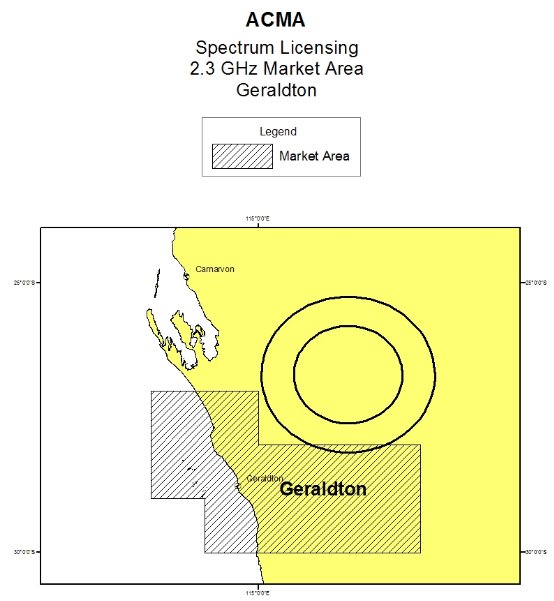
Part 5 Kalgoorlie
East | South | | East | South | | East | South |
118 00 0 | 28 00 0 | | 120 00 0 | 35 00 0 | | 119 00 0 | 31 00 0 |
124 00 0 | 28 00 0 | | 120 00 0 | 33 00 0 | | 118 00 0 | 31 00 0 |
124 00 0 | 35 00 0 | | 119 00 0 | 33 00 0 | | 118 00 0 | 28 00 0 |
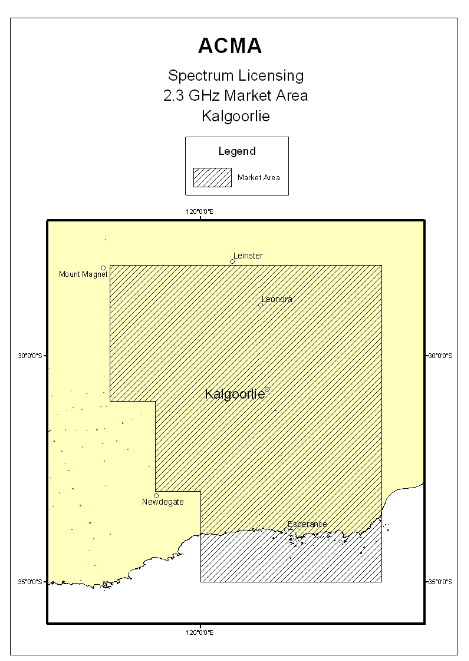
Part 6 Roxby Downs
East | South | | East | South | | East | South |
136 00 0 | 28 00 0 | | 139 00 0 | 32 00 0 | | 136 00 0 | 28 00 0 |
139 00 0 | 28 00 0 | | 136 00 0 | 32 00 0 | | | |
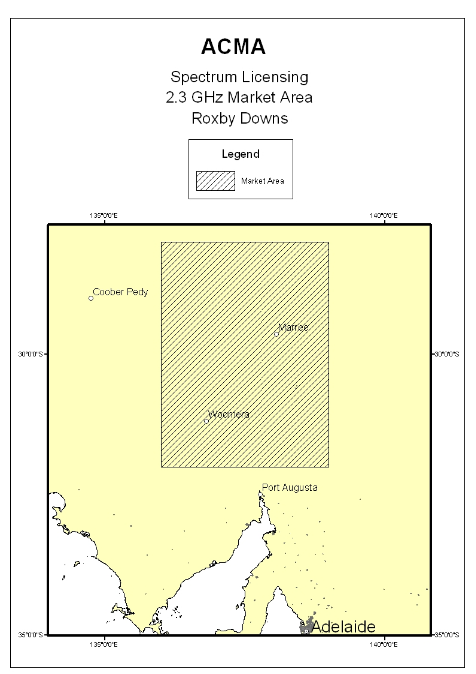
Part 7 South‑West Western Australia
East | South | | East | South | | East | South |
114 00 0 | 30 00 0 | | 116 00 0 | 35 00 0 | | 116 20 0 | 31 40 0 |
118 00 0 | 30 00 0 | | 114 00 0 | 35 00 0 | | 116 15 0 | 31 40 0 |
118 00 0 | 31 00 0 | | 114 00 0 | 33 00 0 | | 116 15 0 | 31 35 0 |
119 00 0 | 31 00 0 | | 115 00 0 | 33 00 0 | | 116 10 0 | 31 35 0 |
119 00 0 | 33 00 0 | | 115 00 0 | 32 25 0 | | 116 10 0 | 31 30 0 |
120 00 0 | 33 00 0 | | 116 10 0 | 32 25 0 | | 115 00 0 | 31 30 0 |
120 00 0 | 35 00 0 | | 116 10 0 | 32 20 0 | | 115 00 0 | 31 00 0 |
119 00 0 | 35 00 0 | | 116 15 0 | 32 20 0 | | 114 00 0 | 31 00 0 |
119 00 0 | 36 00 0 | | 116 15 0 | 32 15 0 | | 114 00 0 | 30 00 0 |
116 00 0 | 36 00 0 | | 116 20 0 | 32 15 0 | | | |
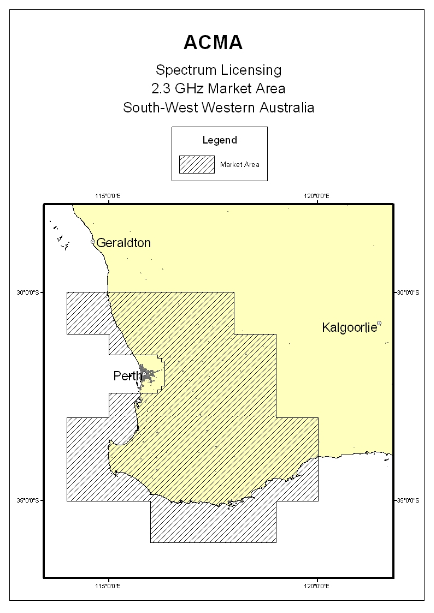
Part 8 Telfer Mine
East | South | | East | South | | East | South |
121 00 0 | 22 00 0 | | 124 00 0 | 19 00 0 | | 121 00 0 | 22 00 0 |
124 00 0 | 22 00 0 | | 121 00 0 | 19 00 0 | | | |
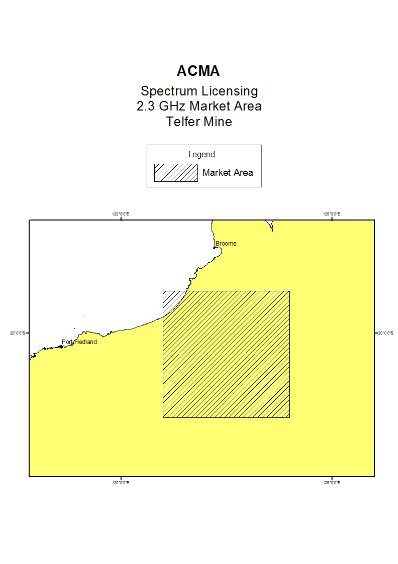
Part 9 Western New South Wales / Bourke
East | South | | East | South | | East | South |
147 00 0 | 33 00 0 | | 149 00 0 | 28 00 0 | | 148 00 0 | 32 00 0 |
145 00 0 | 33 00 0 | | 149 00 0 | 31 00 0 | | 147 00 0 | 32 00 0 |
145 00 0 | 28 00 0 | | 148 00 0 | 31 00 0 | | 147 00 0 | 33 00 0 |
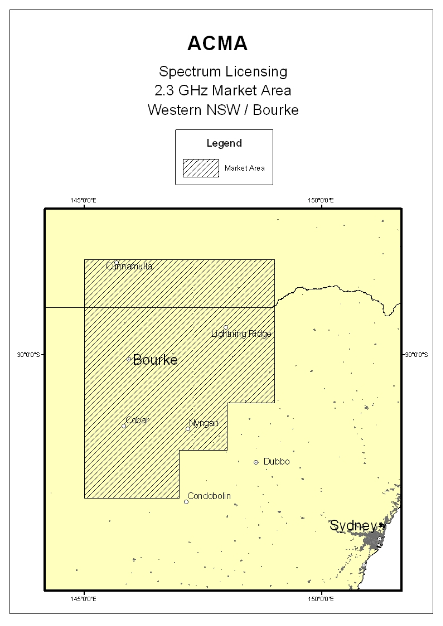
Part 10 Mid West Radio Quiet Zone
East | South | | East | South | | East | South |
115 00 0 | 28 00 0 | | 118 00 0 | 25 00 0 | | 115 00 0 | 28 00 0 |
115 00 0 | 25 00 0 | | 118 00 0 | 28 00 0 | | | |
This area will be subject to the additional licence condition in clause 7 in Schedule 4 to the sample licence conditions.
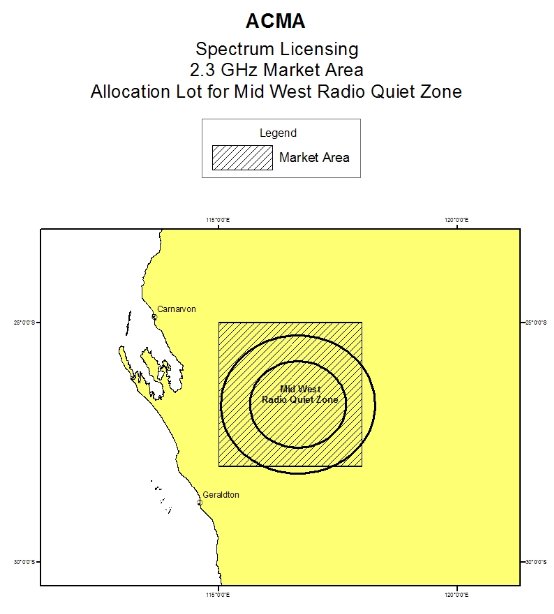
Part 11 Gascoyne / Pilbara
East | South | | East | South | | East | South |
115 00 0 | 19 00 0 | | 118 00 0 | 25 00 0 | | 112 00 0 | 25 00 0 |
121 00 0 | 19 00 0 | | 115 00 0 | 25 00 0 | | 113 00 0 | 25 00 0 |
121 00 0 | 22 00 0 | | 115 00 0 | 27 00 0 | | 113 00 0 | 21 00 0 |
124 00 0 | 22 00 0 | | 113 00 0 | 27 00 0 | | 115 00 0 | 21 00 0 |
124 00 0 | 28 00 0 | | 113 00 0 | 26 00 0 | | 115 00 0 | 19 00 0 |
118 00 0 | 28 00 0 | | 112 00 0 | 26 00 0 | | | |
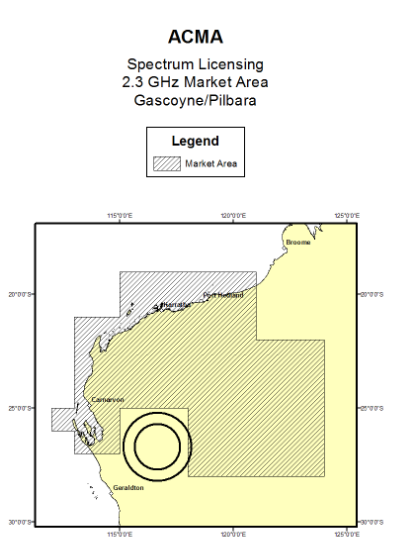
Part 12 Kimberley
East | South | | East | South | | East | South |
124 00 0 | 13 00 0 | | 129 00 0 | 26 00 0 | | 121 00 0 | 16 00 0 |
127 00 0 | 13 00 0 | | 124 00 0 | 26 00 0 | | 124 00 0 | 16 00 0 |
127 00 0 | 19 00 0 | | 124 00 0 | 19 00 0 | | 124 00 0 | 13 00 0 |
129 00 0 | 19 00 0 | | 121 00 0 | 19 00 0 | | | |

Part 13 Goldfields
East | South | | East | South | | East | South |
124 00 0 | 26 00 0 | | 125 00 0 | 33 00 0 | | 124 00 0 | 26 00 0 |
129 00 0 | 26 00 0 | | 125 00 0 | 34 00 0 | | | |
129 00 0 | 33 00 0 | | 124 00 0 | 34 00 0 | | | |
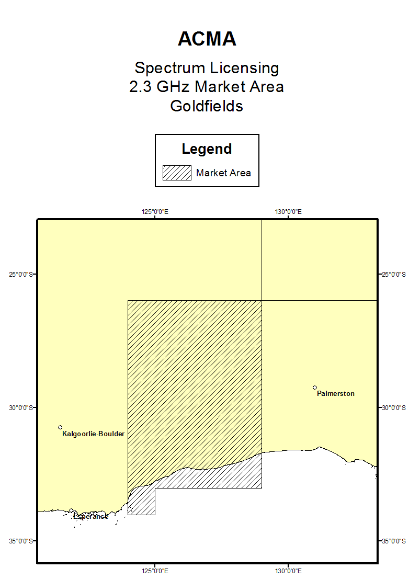
Part 14 Northern Territory
East | South | | East | South | | East | South |
129 00 0 | 19 00 0 | | 133 00 0 | 22 00 0 | | 136 00 0 | 26 00 0 |
136 00 0 | 19 00 0 | | 133 00 0 | 25 00 0 | | 129 00 0 | 26 00 0 |
136 00 0 | 22 00 0 | | 136 00 0 | 25 00 0 | | 129 00 0 | 19 00 0 |
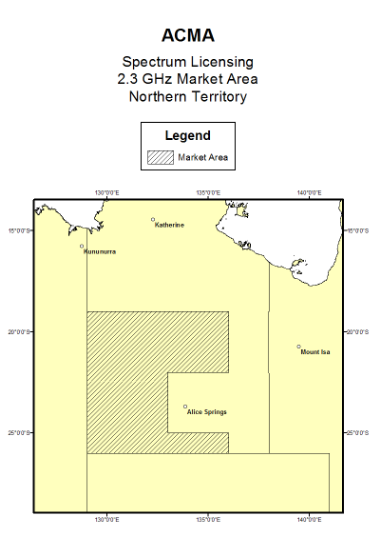
Part 15 South Australia
East | South | | East | South | | East | South |
129 00 0 | 26 00 0 | | 135 00 0 | 34 00 0 | | 132 00 0 | 32 00 0 |
136 00 0 | 26 00 0 | | 134 00 0 | 34 00 0 | | 129 00 0 | 32 00 0 |
136 00 0 | 32 00 0 | | 134 00 0 | 33 00 0 | | 129 00 0 | 26 00 0 |
135 00 0 | 32 00 0 | | 132 00 0 | 33 00 0 | | | |
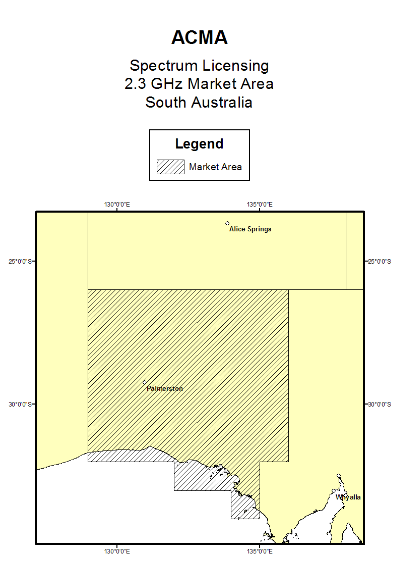
Part 16 North Queensland
East | South | | East | South | | East | South |
132 00 0 | 10 00 0 | | 145 00 0 | 16 00 0 | | 136 00 0 | 13 00 0 |
143 00 0 | 10 00 0 | | 145 00 0 | 20 00 0 | | 132 00 0 | 13 00 0 |
143 00 0 | 11 00 0 | | 146 00 0 | 20 00 0 | | 132 00 0 | 12 00 0 |
144 00 0 | 11 00 0 | | 146 00 0 | 22 00 0 | | 130 00 0 | 12 00 0 |
144 00 0 | 14 00 0 | | 142 00 0 | 22 00 0 | | 130 00 0 | 11 00 0 |
146 00 0 | 14 00 0 | | 142 00 0 | 19 00 0 | | 132 00 0 | 11 00 0 |
146 00 0 | 16 00 0 | | 136 00 0 | 19 00 0 | | 132 00 0 | 10 00 0 |
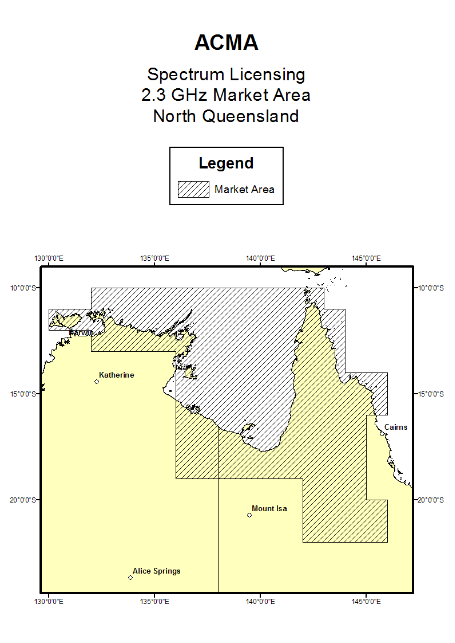
Part 17 Central Queensland
East | South | | East | South | | East | South |
136 00 0 | 22 00 0 | | 149 00 0 | 24 00 0 | | 136 00 0 | 22 00 0 |
148 00 0 | 22 00 0 | | 149 00 0 | 26 00 0 | | | |
148 00 0 | 24 00 0 | | 136 00 0 | 26 00 0 | | | |
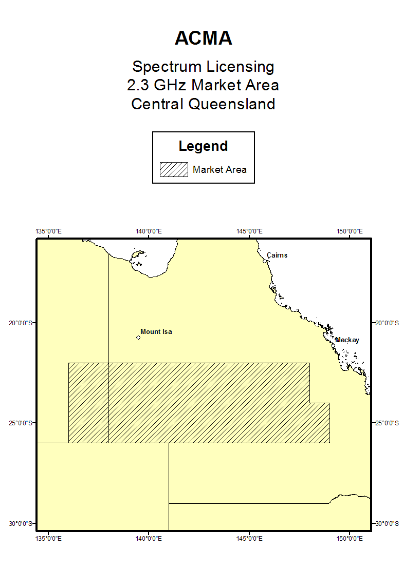
Part 18 Cameron Corner
East | South | | East | South | | East | South |
136 00 0 | 26 00 0 | | 145 00 0 | 28 00 0 | | 139 00 0 | 28 00 0 |
149 00 0 | 26 00 0 | | 145 00 0 | 31 00 0 | | 136 00 0 | 28 00 0 |
149 00 0 | 28 00 0 | | 139 00 0 | 31 00 0 | | 136 00 0 | 26 00 0 |
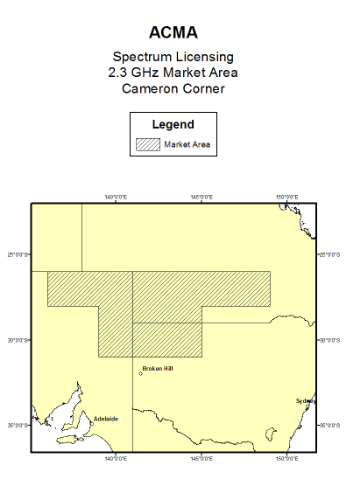
Part 19 Areas within remote and rural Australia that are not available
Division 1 Alice Springs
East | South | | East | South | | East | South |
136 00 0 | 25 00 0 | | 133 00 0 | 22 00 0 | | 136 00 0 | 25 00 0 |
136 00 0 | 22 00 0 | | 133 00 0 | 25 00 0 | | | |
Note All of the 2.3 GHz band spectrum for the Alice Springs geographic area is currently spectrum licensed and therefore unavailable in this allocation.
Division 2 Mt Isa
East | South | | East | South | | East | South |
136 00 0 | 22 00 0 | | 142 00 0 | 19 00 0 | | 136 00 0 | 22 00 0 |
142 00 0 | 22 00 0 | | 136 00 0 | 19 00 0 | | | |
Note All of the 2.3 GHz band spectrum for the Mt Isa geographic area is currently spectrum licensed and therefore unavailable in this allocation.
Division 3 Telfer Mine
East | South | | East | South | | East | South |
121 00 0 | 19 00 0 | | 124 00 0 | 22 00 0 | | 121 00 0 | 19 00 0 |
124 00 0 | 19 00 0 | | 121 00 0 | 22 00 0 | | | |
Note An area adjacent to this area, described in Part 8, is a separately defined geographic area that is available in this allocation.
Schedule 3 Description of available spectrum / lots
(subsections 2.2 (4) and 2.12 (2))
Item | Area | Lower Frequency (MHz) | Upper Frequency (MHz) | Available Bandwidth (MHz) |
1 | Darwin | 2302 2337 2365 | 2337 2365 2400 | 35 28 35 |
2 | Geraldton | 2302 2337 2365 | 2337 2365 2400 | 35 28 35 |
3 | Kalgoorlie | 2302 2337 2365 | 2337 2365 2400 | 35 28 35 |
4 | Roxby Downs | 2302 2337 2365 | 2337 2365 2400 | 35 28 35 |
5 | South‑West Western Australia | 2302 2337 2365 | 2337 2365 2400 | 35 28 35 |
6 | Telfer Mine | 2309 2323 2337 2365 2379 | 2316 2330 2358 2372 2400 | 7 7 21 7 21 |
7 | Western New South Wales / Bourke | 2302 2337 | 2337 2365 | 35 28 |
8 | Mid West Radio Quiet Zone | 2302 2337 2365 | 2337 2365 2400 | 35 28 35 |
9 | Gascoyne / Pilbara | 2302 2337 2365 | 2337 2365 2400 | 35 28 35 |
10 | Kimberley | 2302 2337 2365 | 2337 2365 2400 | 35 28 35 |
11 | Goldfields | 2302 2337 2365 | 2337 2365 2400 | 35 28 35 |
12 | Northern Territory | 2302 2337 2365 | 2337 2365 2400 | 35 28 35 |
13 | South Australia | 2302 2337 2365 | 2337 2365 2400 | 35 28 35 |
14 | North Queensland | 2302 2337 2365 | 2337 2365 2400 | 35 28 35 |
15 | Central Queensland | 2302 2337 2365 | 2337 2365 2400 | 35 28 35 |
16 | Cameron Corner | 2302 2337 2365 | 2337 2365 2400 | 35 28 35 |
Schedule 4 Sample licence
(section 2.9 and subsection 2.14 (1))
This Schedule sets out a sample spectrum licence, and the conditions that may be included in the spectrum licence. The frequency and geographical limits of the licence are examples only.
Note The sample licence includes Schedules which are Schedules to the licence and not Schedules to this Marketing Plan.
COMMONWEALTH OF AUSTRALIA
AUSTRALIAN COMMUNICATIONS AND MEDIA AUTHORITY
Radiocommunications Act 1992
Sample Spectrum Licence
This licence is issued under Part 3.2 of the Radiocommunications Act 1992 (‘the Act’) by the person identified in item 8 of Schedule 1 to this licence.
1. The person named in item 1 of Schedule 1 to this licence (‘the licensee’), or a person authorised under subsection 68 (1) of the Act, is authorised to operate radiocommunications devices in accordance with:
(a) the Act; and
(b) the core conditions set out in Schedule 2 to this licence; and
(c) the statutory conditions set out in Schedule 3 to this licence; and
(d) other conditions included in this licence by ACMA and set out in Schedule 4 to this licence.
2. This licence comes into force on the date shown in item 4 of Schedule 1 and remains in force until the end of the day shown in item 5 of Schedule 1.
3. Unless the contrary intention appears, terms and expressions used in this licence have the meaning given to them by the Radiocommunications Spectrum Marketing Plan (2.3 GHz Band) 2009 (‘the Marketing Plan’).
Licensee:
Client number:
Band release: 2.3 GHz Band
Licence number:
Licence Schedule 1 Licence and technical details
Part 1 Licence details
Item | Details | |
Licensee details |
1 | Name of licensee Address of licensee | |
2 | Client number | |
3 | Band release | 2.3 GHz Band |
Licence details |
4 | Date of licence effect | |
5 | Date of licence expiry | 24 July 2015 |
6 | Licence number | |
7 | Date of licence issue | |
8 | Issuing officer | |
Part 2 Technical details
Item | Details | |
Core condition — frequency band of licence |
9 | Lower limit of frequency band | XXXX.X MHz |
10 | Upper limit of frequency band | YYYY.Y MHz |
Core condition — emission limits outside the area (these are worked out in accordance with Schedule 5 to the Marketing Plan) |
11 | Horizontally radiated power for core condition 4 | 60 dBm per 30 kHz |
Core condition — emission limits outside the band (these are worked out in accordance with Schedule 6 to the Marketing Plan) | |
12 | Range of offsets for core condition 10 (a) | 0 to 0.5 MHz | |
13 | Radiated maximum true mean power for core condition 10 (a) | 10 dBm per 30 kHz | |
14 | Range of offsets for core condition 10 (b) | 0 to 1.0 MHz | |
15 | Radiated maximum true mean power for core condition 10 (b) | 10 dBm per 30 kHz | |
16 | Range of offsets for core condition 10 (c) | 0.5 to 1.0 MHz | |
17 | Radiated maximum true mean power for core condition 10 (c) | 5 dBm per 30 kHz | |
18 | Range of offsets for core condition 10 (d) | 1.0 to 3.5 MHz | |
19 | Radiated maximum true mean power for core condition 10 (d) | 5 dBm per 30 kHz | |
20 | Range of offsets for core condition 10 (e) | 1.0 MHz to 3.5 MHz | |
21 | Radiated maximum true mean power for core condition 10 (e) | 0 dBm per 30 kHz | |
22 | Range of offsets for core condition 10 (f) | 3.5 MHz to 5.0 MHz | |
23 | Radiated maximum true mean power for core condition 10 (f) | 0 dBm per 30 kHz | |
24 | Range of offsets for core condition 10 (g) | 3.5 MHz to 7.0 MHz | |
25 | Radiated maximum true mean power for core condition 10 (g) | ‑10 dBm per 30 kHz | |
26 | Range of offsets for core condition 10 (h) | 5.0 MHz to 7.0 MHz | |
27 | Radiated maximum true mean power for core condition 10 (h) | ‑10 dBm per 30 kHz | |
28 | Range of offsets for core condition 10 (i) | 7.0 MHz to 17.5 MHz | |
29 | Radiated maximum true mean power for core condition 10 (i) | ‑16 dBm per 30 kHz | |
30 | Range of offsets for core condition 10 (j) | 7.0 MHz to 17.5 MHz | |
31 | Radiated maximum true mean power for core condition 10 (j) | ‑16 dBm per 30 kHz | |
32 | Band for core condition 11 (a) | 9 kHz to 150 kHz | |
33 | Radiated mean power for core condition 11 (a) | ‑36 dBm per 1 kHz | |
34 | Band for core condition 11 (b) | 150 kHz to 30 MHz | |
35 | Radiated mean power for core condition 11 (b) | ‑36 dBm per 10 kHz | |
36 | Band for core condition 11 (c) | 30 MHz to 1 GHz | |
37 | Radiated mean power for core condition 11 (c) | ‑36 dBm per 100 kHz | |
38 | Band for core condition 11 (d) | 1.0 GHz to 4.8 GHz | |
39 | Radiated mean power for core condition 11 (d) | ‑1 dBm per 1 MHz | |
40 | Band for core condition 11 (e) | 4.8 GHz to 24.0 GHz | |
41 | Radiated mean power for core condition 11 (e) | ‑30 dBm per 1 MHz | |
42 | Band for core condition 12 (a) | 9 kHz to 1 GHz | |
43 | Radiated mean power for core condition 12 (a) | ‑57 dBm per 100 kHz | |
44 | Band for core condition 12 (b) | 1.0 GHz to 4.8 GHz | |
45 | Radiated mean power for core condition 12 (b) | ‑20 dBm per 1 MHz | |
46 | Band for core condition 12 (c) | 4.8 GHz to 24.0 GHz | |
47 | Radiated mean power for core condition 12 (c) | ‑47 dBm per 1 MHz | |
Device registration | |
48 | Section 145 Determination for registration of transmitters | Radiocommunications (Unacceptable Levels of Interference — 2.3 GHz Band) Determination 2009 | |
| | | | |
Part 3 Geographic areas
Core condition — geographic area of licence
For core condition 2, the area or aggregate of areas within which operation of radiocommunications devices is authorised by this licence is that area of land described by the aggregation of rectangular areas, each having:
(a) a north to south (latitude) and east to west (longitude) orientation; and
(b) a south‑west corner that is represented by a geographic coordinate set out in Table 1; and
(c) a north‑east corner that is represented by a geographic coordinate set out opposite to the coordinate set out in Table 1.
Table 1 | Table 2 |
South‑west corner | North‑east corner |
South | East | South | East |
28 35 0 | 153 05 0 | 26 50 0 | 154 00 0 |
28 20 0 | 152 50 0 | 26 50 0 | 153 05 0 |
28 05 0 | 152 30 0 | 26 50 0 | 152 50 0 |
(Example coordinates only)
Licence Schedule 2 Core conditions
Frequency band
1. This licence authorises the operation of radiocommunications devices in the frequency band that consists of the contiguous range of frequencies between:
(a) the lower frequency limits set out in item 9 of Schedule 1; and
(b) the upper frequency limit set out in item 10 of Schedule 1.
Geographic area
2. This licence authorises the operation of radiocommunications devices in the geographic area set out in Part 3 of Schedule 1.
Emission limits outside the geographic area
3. Core conditions 4 and 5 apply in each geographic area:
(a) that is outside the geographic areas set out at Part 3 of Schedule 1; and
(b) for which there is no agreement for the purposes of core condition 7 in force; and
(c) for which the licensee does not hold another spectrum licence in the 2.3 GHz band.
4. The level of in‑band radio emissions permitted in the geographic area to which this condition applies, is limited to the horizontally radiated power set out in item 11 of Schedule 1.
5. The level of emission in a geographic area to which this condition applies is to be estimated with a level of confidence not less than 95 percent that the true level of emission remains below the relevant emission limit plus 2 dB.
Note 1 This core condition is designed to assist technological neutrality and at all times limits the power spectral density of a terrestrial transmitter located anywhere within the geographic area of the licence to a specified EIRP in a rectangular bandwidth of 30 kHz. The limit has an important function in the management of receiver intermodulation. There may be additional constraints on radiated power caused by the device boundary criterion of the relevant section 145 determination or the compatibility requirements of related Advisory Guidelines.
Note 2 Except where the occupied bandwidth of a transmitter is less than 30 kHz, the core condition does not place a limit on the total radiated power for a transmitter. However, total radiated power is limited indirectly by:
(a) the cost of high power amplifiers; and
(b) the general requirement to use low powers in cellular systems; and
(c) the emission limits outside the band becoming increasingly difficult to satisfy as total transmitter power increases.
6. Core condition 7 applies in each geographic area that is outside the geographic areas set out at Part 3 of Schedule 1 and:
(a) for which there is an agreement in force for the purposes of that core condition; or
(b) for which the licensee holds another spectrum licence in the 2.3 GHz band.
7. The emission limits outside the area are the level that does not cause the core emission limits to be exceeded in any geographic area:
(a) for which there is no agreement for the purposes of this core condition in force; and
(b) for which the licensee does not hold another spectrum licence in the 2.3 GHz band.
Emission limits outside the band
8. Core conditions 9 to 13 apply in each part of the spectrum:
(a) for which there is no agreement for the purposes of core condition 15 in force; and
(b) for which the licensee does not hold another spectrum licence in the 2.3 GHz band.
9. For this Part, the maximum permitted levels of emission outside the frequency band of the licence apply unless:
(a) a written agreement exists, between the licensee and all the affected
licensees of frequency‑adjacent spectrum licences, setting out
increased maximum permitted levels; and
(b) if non‑spectrum licensed space is affected, the licensee provides to ACMA written agreement with non‑spectrum licensees to increase maximum permitted levels and ACMA has varied the relevant licence conditions.
10. For radio emission that is not spurious emission, caused by transmitters, at frequencies outside the frequency band of the licence, the emission limits
outside the band are:
(a) for frequency bands only containing frequencies that are removed from the upper frequency limit of the frequency band of the licence by offsets within the range set out in item 12 of Schedule 1 — the radiated maximum true mean power set out in item 13 of Schedule 1; and
(b) for frequency bands only containing frequencies that are removed from the lower frequency limit of the licence by offsets within the range set out in item 14 of Schedule 1 — the radiated maximum true mean power set out in item 15 of Schedule 1; and
(c) for frequency bands only containing frequencies that are removed from the upper frequency limit of the licence by offsets within the range set out in item 16 of Schedule 1 — the radiated maximum true mean power set out in item 17 of Schedule 1; and
(d) for frequency bands only containing frequencies that are removed from the lower frequency limit of the licence by offsets within the range set out in item 18 of Schedule 1 — the radiated maximum true mean power set out in item 19 of Schedule 1; and
(e) for frequency bands only containing frequencies that are removed from the upper frequency limit of the licence by offsets within the range set out in item 20 of Schedule 1 — the radiated maximum true mean power set out in item 21 in Part 2 of Schedule 1; and
(f) for frequency bands only containing frequencies that are removed from the lower frequency limit of the licence by offsets within the range set out in item 22 of Schedule 1 — the radiated maximum true mean power set out in item 23 of Schedule 1; and
(g) for frequency bands only containing frequencies that are removed from the upper frequency limit of the licence by offsets within the range set out in item 24 of Schedule 1 — the radiated maximum true mean power set out in item 25 of Schedule 1; and
(h) for frequency bands only containing frequencies that are removed from the lower frequency limit of the licence by offsets within the range set out in item 26 of Schedule 1 — the radiated maximum true mean power set out in item 27 of Schedule 1; and
(i) for frequency bands only containing frequencies that are removed from the upper frequency limit of the licence by offsets within the range set out in item 28 of Schedule 1 — the radiated maximum true mean power set out in item 29 of Schedule 1; and
(j) for frequency bands only containing frequencies that are removed from the lower frequency limit of the licence by offsets within the range set out in item 30 of Schedule 1 — the radiated maximum true mean power is set out in item 31 of Schedule 1.
11. For radio emission that is spurious emission from transmitters at frequencies outside the frequency band of the licence, the emission limits outside the band are:
(a) a radiated mean power set out in item 33 of Schedule 1 and measured within a 1 kHz rectangular bandwidth that is within the band set out in item 32 of Schedule 1; and
(b) a radiated mean power set out in item 35 of Schedule 1 and measured within a 10 kHz rectangular bandwidth that is within the band set out in item 34 of Schedule 1; and
(c) a radiated mean power set out in item 37 of Schedule 1 and measured within a 100 kHz rectangular bandwidth that is within the band set out in item 36 of Schedule 1; and
(d) a radiated mean power set out in item 39 of Schedule 1 and measured within a 1 MHz rectangular bandwidth that is within the band set out in item 38 of Schedule 1; and
(e) a radiated mean power set out in item 41 of Schedule 1 and measured within a 1 MHz rectangular bandwidth that is within the band set out in item 40 of Schedule 1.
12. For radio emission caused by receivers, the emission limits outside the band are:
(a) a radiated mean power set out in item 43 of Schedule 1 and measured within a 100 kHz rectangular bandwidth that is within the band set out in item 42 of Schedule 1; and
(b) a radiated mean power set out in item 45 of Schedule 1 and measured within a 1 MHz rectangular bandwidth that is within the band set out in item 44 of Schedule 1; and
(c) a radiated mean power set out in item 47 of Schedule 1 and measured within a 1 MHz rectangular bandwidth that is within the band set out in item 46 of Schedule 1.
13. The level of emission outside the band of the licence is to be estimated with a level of confidence not less than 95 % that the true level of emission remains below the relevant emission limit plus 2 dB.
14. Core condition 15 applies in each part of the spectrum:
(a) for which there is an agreement in force for the purposes of that core condition; or
(b) for which the licensee holds another spectrum licence in the 2.3 GHz band.
15. The emission limits outside the band are the level that does not cause the base emission limits to be exceeded in any part of the spectrum:
(a) for which there is no agreement for the purposes of this core condition in force; and
(b) for which the licensee does not hold another spectrum licence in the 2.3 GHz band.
Licence Schedule 3 Statutory conditions
Liability to pay charges
1. The licensee must meet all obligations to pay charges fixed by determinations made under section 294 of the Act and subsection 60 (1) of the Australian Communications and Media Authority Act 2005.
Third party use
2. (1) The licensee must notify any person authorised to operate radiocommunications devices under the licence of that person’s obligations under the Act, in particular of any registration requirements under Part 3.5 of the Act for operation of radiocommunications devices under the licence, and any rules about third party use made under subsection 68 (3) of the Act.
(2) Each operation of a radiocommunications device under the licence by a person other than the licensee must comply with rules made by ACMA under subsection 68 (3) of the Act.
Transmitter registration requirements
3. The licensee must not operate a transmitter under this licence unless:
(a) the transmitter has been exempted from the registration requirements under clause 4; or
(b) both of the following apply:
(i) the requirements of ACMA under Part 3.5 of the Act relating to registration of the transmitter have been met; and
(ii) the transmitter complies with the details about it that have been entered in the Register of Radiocommunications Licences.
Exemption from registration requirements
4. A mobile or indoor fixed transmitter that operates in the 2.3 GHz band with a radiated true mean power within its effective occupied band that is always less than or equal to 21 dBm EIRP per 30 kHz is not required to be registered.
Note 1 The Radiocommunications (Unacceptable Levels of Interference — 2.3 GHz band) Determination 2009 sets out the unacceptable levels of interference for the purpose of registering transmitters to be operated under this licence, and is to be used for the issue of certificates by accredited persons under subsection 145 (3) of the Act .
Note 2 Although not mandatory, the registration of receivers is advised because 1 of the matters ACMA will take into account in settling interference is the time of registration of the receiver involved in the interference.
Residency
5. (1) At all times when the licensee derives income, profits or gains from operating radiocommunications devices under this licence, or from authorising others to do so:
(a) the licensee must be an Australian resident; or
(b) the income, profits or gains must be attributable to a permanent establishment in Australia through which the licensee carries on business.
(2) At all times when an authorised person derives income, profits or gains from allowing third parties to operate radiocommunications devices under the licence:
(a) the authorised person must be an Australian resident; or
(b) the income, profits or gains must be attributable to a permanent establishment in Australia through which the authorised person carries on business.
(3) In this clause:
Australian resident has the same meaning as in the Income Tax Assessment Act 1997.
authorised person means a person authorised under section 68 of the Act by the licensee to operate radiocommunications devices under this licence.
permanent establishment has the same meaning as in:
(a) if the licensee or authorised person (as appropriate) is a resident of a country or other jurisdiction with which Australia has an agreement, within the meaning of the International Tax Agreements Act 1953 — that agreement; or
(b) in any other case — the Income Tax Assessment Act 1997.
Licence Schedule 4 Conditions included by ACMA
Additional emission limits
1. Subject to clause 8, unwanted emissions of any transmitter operating under this licence must not exceed the following limits in the band 2290–2300 MHz:
(a) for a transmitter operating in the band 2302–2309 MHz — a radiated unwanted emission level of ‑5 dBm measured in a 1 kHz rectangular bandwidth;
(b) for a transmitter operating in the band 2309–2400 MHz — a radiated unwanted emission level of ‑30 dBm measured in a 1 kHz rectangular bandwidth.
Note The above requirement arises from the need to protect space services in the adjacent band 2290–2300 MHz.
The radiated unwanted emission level for transmitters operating in the band 2302–2309 MHz is less stringent than those in the remainder of the band in consideration of the practical limitations of filter implementation for high power transmitters.
Responsibility to manage interference
2. The licensee must:
(a) manage interference between radiocommunications devices operated under this licence; and
(b) manage interference between radiocommunications devices operated under this licence and under each other spectrum licence held by the licensee.
Note In this licence, to ‘manage interference’ means:
(a) investigating the possible causes of the interference; and
(b) taking all steps reasonably necessary to resolve disputes about interference where more than 1 person is involved; and
(c) taking steps (or requiring persons authorised to operate devices under this licence to take steps) reasonably likely to reduce interference to acceptable levels; and
(d) negotiating with other persons to reduce interference to acceptable levels.
Co‑sited devices
3. (1) Interference can occur between radiocommunications devices that are co‑sited.
(2) If:
(a) interference occurs between a radiocommunications device operated under this licence and any other radiocommunications device located within 500 metres of the first device, and interference is measured by reference to the location of the phase centre of the antenna used with each device; and
(b) the interference does not occur because a radiocommunications device is operated in a manner that does not comply with the conditions of the relevant licence; and
(c) either the licensee or the holder (third party authorisee) of the other licence wishes to resolve the interference;
the licensee must take reasonable steps to negotiate arrangements that are likely to reduce the interference to acceptable levels with:
(d) the holder of the other licence; or
(e) if a site manager is responsible for managing interference at that location — the site manager.
Information for Register
4. The licensee must give ACMA all information ACMA requires from time to time for inclusion in the Register of Radiocommunications Licences.
International coordination
5. If operation of a transmitter under this licence causes harmful interference to a receiver that:
(a) operates in accordance with International Telecommunication Union Radio Regulations; and
(b) is located in a country other than Australia;
the transmission must cease.
Agreements for purpose of core conditions
6. If a licensee enters into an agreement for the purpose of:
(a) core condition 7 (about emission limits outside the geographic area of this licence); or
(b) core condition 15 (about emission limits outside the frequency band of
this licence); or
(c) both of those core conditions;
the agreement must be in accordance with the form set out in Schedule 5.
Protection of the Mid West Radio Quiet Zone
7. In relation to the place at latitude 2642’ 15” South, longitude 116 39’ 32” East (GDA94) (‘the site’), the licensee must not use a radiocommunications device to cause an emission in the 2.3 GHz band:
(a) between 100 km and 160 km of the site unless the licensee ensures that the expected power spectral density of any such emission arriving at a point 15 m above the ground at the site would be no greater than ‑232 dBm per Hz; and
(b) within 100 km of the site.
Protection of Earth stations
8. The licensee must comply with the requirements specified in Appendix 7 of the Radio Regulations of the International Telecommunication Union relating to the levels of interference protection to be afforded to receiving Earth stations.
Note Licensees are advised that there is an international treaty between the Australian government and the European Space Agency in relation to interference protection provided to its receiving Earth station facilities. The treaty specifies interference protection requirements with which licensees must comply. Existing Earth station receiving facilities are listed in Part 4 of the Radiocommunications Advisory Guidelines (Managing Interference from Transmitters — 2.3 GHz Band) 2009.
Licence Schedule 5 Form of agreement for core conditions
AGREEMENT made on [insert date]
BETWEEN A [insert name of party] and B [insert name of party].
1. BACKGROUND
A holds spectrum licence [details of A’s licence].
B holds spectrum licence [details of B’s licence].
2. B agrees with A for [core condition 7 or core condition 15 or core conditions 7 and 15] of A’s licence in relation to B’s licence.
3. B may terminate this agreement at will by notice in writing given to A.
SIGNED on behalf of A:
SIGNED on behalf of B:
Licence Schedule 6 Licence Notes
Variation to licence conditions
1. ACMA may, with the written agreement of the licensee, vary this licence by including 1 or more further conditions, or revoking or varying any conditions of the licence. However, the conditions as varied must still comply with the requirements about licence conditions in Subdivision C of Division 1 of Part 3.2 of the Act.
2. ACMA may, by written notice given to the licensee, vary this licence by including 1 or more further conditions, or revoking or varying any non core conditions of the licence. However, the licence as varied must still comply with the requirements about licence conditions in Subdivision C of Division 1 of Part 3.2 of the Act.
Guidelines
3. ACMA has issued written Advisory Guidelines under section 262 of the Act about:
(a) coordinating the use of transmitters operated under this licence with receivers, including receivers operated in apparatus licensed and class licensed systems; and
Note See Radiocommunications Advisory Guidelines (Managing Interference from Transmitters — 2.3 GHz Band) 2009.
(b) coordinating the use of receivers in systems operated under this licence with transmitters operating under other radiocommunications licences; and
Note See Radiocommunications Advisory Guidelines (Managing Interference to Receivers — 2.3 GHz Band) 2009.
(c) ways in which a device can be registered although it does not comply with the requirements of the Radiocommunications (Unacceptable Levels of Interference — 2.3 GHz Band) Determination 2009.
Note See Radiocommunications Advisory Guidelines (Registration of Devices under Spectrum Licences without an Interference Impact Certificate) 1998.
4. The Advisory Guidelines should be read in conjunction with the Radiocommunications (Unacceptable Levels of Interference — 2.3 GHz Band) Determination 2009 made under subsection 145 (4) of the Act. That Determination sets out the unacceptable levels of interference for the purpose of the registration of transmitters to be operated under this licence. Licensees (and accredited persons) should follow the Advisory Guidelines before transmitters are operated. ACMA intends to afford protection to receivers in accordance with the Advisory Guidelines in the settlement of interference disputes. Copies of the Advisory Guidelines are available from ACMA.
Suspension and cancellation of spectrum licences
5. ACMA may, by written notice given to a licensee, suspend or cancel a spectrum licence where ACMA is satisfied that the licensee, or a person authorised by the licensee to operate a radiocommunications device under the licence, has:
(a) contravened a condition of the licence; or
(b) in any other way contravened the Act; or
(c) operated a radiocommunications device under the licence, or purportedly under the licence, in contravention of any other law of the Commonwealth, a State or a Territory.
Re‑issue
6. A spectrum licence may not be re‑issued to the same licensee without a price‑based allocation procedure unless:
(a) ACMA is satisfied under subsection 82 (1) of the Act that special circumstances exist as a result of which it would be in the public interest for that licensee to continue to hold that licence; or
(b) the licensee provides a service of a kind determined by the Minister under subsection 82 (3) of the Act for which reissuing licences to the same licensees would be in the public interest.
Trading
7. (1) A licensee may assign or otherwise deal with the whole or any part of a spectrum licence provided that this is done in accordance with any rules determined by ACMA under section 88 of the Act.
(2) An assignment under section 85 of the Act of the whole or part of a licence that involves a change to a licence does not take effect until:
(a) ACMA has been told of the change; and
(b) the Register of Radiocommunications Licences has been altered to take account of the change.
Appeals
8. An application may be made to ACMA for reconsideration of a decision listed under section 285 of the Act. A person affected by and dissatisfied with the decision may seek a reconsideration of the decision by ACMA under subsection 288 (1) of the Act. This decision can be subject to further reconsideration by the Administrative Appeals Tribunal, pursuant to section 292 of the Act and subject to the provisions of the Administrative Appeals Tribunal Act 1975.
Labelling of transmitters
9. A transmitter operated under this licence is to be labelled in accordance with the Radiocommunications (Labelling) Determination 1997.
Schedule 5 Emission limits outside the area
(subsection 2.13 (1))
This Schedule describes the limits placed on emissions outside the area of the licence by transmitters operated under the licence as detailed in the licence.
Note Device registration requirements and coordination with other services may place additional limits on the level of emissions from a transmitter operated under the licence.
Part 1 Base emission limits
1. This Part applies in each part of the spectrum:
(a) for which there is no agreement in force for the purposes of core condition 7 of the licence; and
(b) for which the licensee does not hold another spectrum licence in the 2.3 GHz band.
2. The emission limit outside the area, for frequency bands only containing in‑band frequencies, is a horizontally radiated power of 60 dBm EIRP per 30 kHz.
3. The level of emission outside the area is to be estimated with a level of confidence not less than 95 % that the true level of emission remains below the relevant emission limit plus 2 dB.
4. For clause 2, the level of emission is to be estimated after taking into account:
(a) the kind of antenna; and
(b) the kind of equipment used with the antenna; and
(c) the location and immediate physical environment in which the antenna operates.
Part 2 Other emission limits
1. This Part applies in each part of the spectrum:
(a) for which there is an agreement in force for the purposes of core condition 7; or
(b) for which the licensee holds another spectrum licence in the 2.3 GHz band.
2. The emission limits outside the area are the level that does not cause the base emission limits to be exceeded in any part of the spectrum:
(a) for which there is no agreement for the purposes of core condition 7 in force; and
(b) for which the licensee does not hold another spectrum licence in the 2.3 GHz band.
Schedule 6 Emission limits outside the band
(subsection 2.13 (2))
This Schedule describes the limits placed on emissions, outside the band of the licence, produced by transmitters and receivers operated under the licence.
Note 1 Device registration requirements and coordination with other services may place additional limits on the level of emissions from a transmitter operated under the licence.
Note 2 Emission limits outside the band manage levels of:
(a) modulation and intermodulation products outside the frequency band of the licence associated with:
(i) the transmitted information; and
(ii) where applicable, multi‑carrier transmitters; and
(b) transmitter broadband noise; and
(c) transmitter narrowband signals from frequency combining processes, including multi‑coupling of transmitters into an antenna; and
(d) receiver emissions.
Part 1 Base emission limits
1. This Part applies in each part of the spectrum:
(a) for which there is no agreement for the purposes of core condition 15 in force; and
(b) for which the licensee does not hold another spectrum licence in the 2.3 GHz band.
2. For a radio emission that is:
(a) not a spurious emission; and
(b) caused by a transmitter operating under a spectrum licence issued for the 2.3 GHz band;
the emission limits outside the band for frequency bands containing frequencies that have offsets from the lower frequency limit of the licence are:
(c) within the range 0 kHz to 1 MHz — a radiated maximum true mean power of 10 dBm EIRP per 30 kHz; and
(d) within the range 1 MHz to 3.5 MHz — a radiated maximum true mean power of 5 dBm EIRP per 30 kHz; and
(e) within the range 3.5 MHz to 5 MHz — a radiated maximum true mean power of 0 dBm EIRP per 30 kHz; and
(f) within the range 5 MHz to 7 MHz — a radiated maximum true mean power of ‑10 dBm EIRP per 30 kHz; and
(g) within the range 7 MHz to 17.5 MHz — a radiated maximum true mean power of ‑16 dBm EIRP per 30 kHz.
3. For a radio emission that is:
(a) not a spurious emission; and
(b) caused by a transmitter operating under a spectrum licence issued for the 2.3 GHz band;
the emission limits outside the band for frequency bands containing frequencies that have offsets from the upper frequency limit of the licence are:
(c) within the range 0 kHz to 0.5 MHz — a radiated maximum true mean power of 10 dBm EIRP per 30 kHz; and
(d) within the range 0.5 MHz to 1 MHz — a radiated maximum true mean power of 5 dBm EIRP per 30 kHz; and
(e) within the range 1 MHz to 3.5 MHz — a radiated maximum true mean power of 0 dBm EIRP per 30 kHz; and
(f) within the range 3.5 MHz to 7 MHz — a radiated maximum true mean power of ‑10 dBm EIRP per 30 kHz; and
(g) within the range 7 MHz to 17.5 MHz — a radiated maximum true mean power of ‑16 dBm EIRP per 30 kHz.
4. For a radio emission that is:
(a) a spurious emission; and
(b) caused by transmitters operating under spectrum licences issued for the 2.3 GHz band; and
(c) at frequencies outside the frequency band of the licence;
the emission limit outside the band is a radiated mean power of:
(d) ‑36 dBm EIRP measured within a 1 kHz rectangular bandwidth that is within the band 9 kHz to 150 kHz; and
(e) ‑36 dBm EIRP measured within a 10 kHz rectangular bandwidth that is within the band 150 kHz to 30 MHz; and
(f) ‑36 dBm EIRP measured within a 100 kHz rectangular bandwidth that is within the band 30 MHz to 1 GHz; and
(g) ‑1 dBm EIRP measured within a 1 MHz rectangular bandwidth that is within the band 1 GHz to 4.8 GHz; and
(h) ‑30 dBm EIRP measured within a 1 MHz rectangular bandwidth that is within the band 4.8 GHz to 24 GHz.
5. For a radio emission that is:
(a) caused by receivers operating under spectrum licences issued for the 2.3 GHz band; and
(b) at frequencies outside the frequency band of the licence;
the emission limit outside the band is a radiated mean power of:
(c) ‑57 dBm EIRP measured within a 100 kHz rectangular bandwidth that is within the band 9 kHz to 1 GHz; and
(d) ‑20 dBm EIRP measured within a 100 kHz rectangular bandwidth that is within the band 1 GHz to 4.8 GHz; and
(e) ‑47 dBm EIRP measured within a 100 kHz rectangular bandwidth that is within the band 4.8 GHz to 24.0 GHz.
6. For clause 2 to 5, the level of emission is to be estimated after taking into account:
(a) the kind of antenna; and
(b) the kind of equipment used with the antenna; and
(c) the location and immediate physical environment in which the antenna operates.
Part 2 Other emission limits
1. This Part applies in each part of the spectrum:
(a) for which there is an agreement in force for the purposes of core condition 15; or
(b) for which the licensee holds another spectrum licence in the 2.3 GHz band.
2. The emission limits outside the band are the level that does not cause the base emission limits to be exceeded in any part of the spectrum:
(a) for which there is no agreement for the purposes of core condition 15 in force; and
(b) for which the licensee does not hold another spectrum licence in the 2.3 GHz band.
Part 3 Additional emission limits
1. Additional emission limits outside the band of the licence are specified as a condition of the licence to protect sensitive deep space systems. The emission limits apply to unwanted emissions from transmitters falling in the band 2290–2300 MHz.
2. The additional emission limits are:
(a) for transmitters operating in the band 2302‑2309 MHz — a radiated unwanted emission level of ‑5 dBm EIRP measured in any 1 kHz rectangular bandwidth in the band 2290‑2300 MHz; and
(b) for transmitters operating in the band 2309‑2400 MHz — a radiated unwanted emission level of ‑30 dBm EIRP measured in any 1 kHz rectangular bandwidth in the band 2290‑2300 MHz.

















